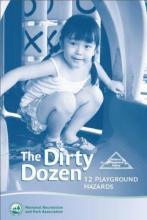
The National Recreation and Park Association (NRPA) is committed to promoting safe play environments for children. When the National Playground Safety Institute (NSPI) was formed as part of NRPA, the NPSI Board of Directors along with their instructors prioritized a list of what they considered to be the top twelve safety issues that result in playground injuries. The list they compiled is generic in nature and easily understood as a reference for educators, parents, and caregivers as well as agency professionals. Published as The Dirty Dozen, the pamphlet has changed in appearance over the years but the content has remained the same. The National Recreation and Park Association has granted the publication rights to organizations and insurance companies to reproduce this information to promote playground safety.1
The twelve common causes of playground injuries are:
- Improper Protective Surfacing. Surfaces such as concrete, asphalt, or packed earth are not acceptable as surfaces under playground equipment. Surfaces such as engineered wood fiber, wood mulch, shredded rubber, rubber tiles, poured-in-place rubber, sand, and pea gravel offer protection as they cushion a fall.
- Inadequate Fall or Use Zone. The use zone is the protective surface zone under and around playground equipment where a child might fall. This zone extends a minimum of six feet in all directions from the edge of stationary play equipment. Zones for slides higher than six feet are equal to the height of the platform or slide entrance. Zones for swings are equal to two times the height of the pivots or swing hangers.
- Protrusion and Entanglement Hazards. A component or piece of hardware that is capable of impaling or cutting should a child fall against it is a hazard. Examples include bolt ends that extend more than two threads beyond the face of the nut and open S type hooks. Some gaps between equipment pieces and unanchored ropes are also considered dangerous.
- Entrapment in Openings. A space or opening in playground equipment where the head of a child may become entrapped is a hazard. No opening may measure between three and one-half inches and nine inches.
- Insufficient Equipment Spacing. Insufficient spacing causes overcrowding of a play area creating a safety hazard. There should be a minimum spacing of six feet between two play structures that are less than thirty inches in height or nine feet if higher than thirty inches. Areas for swings, slides, standing rocking equipment, and merry-go-rounds may not overlap use zones.
- Trip Hazards. Exposed components or items such as concrete borders, tree roots and stumps, rocks, and elevation changes are all common trip hazards
- Lack of Supervision. Playgrounds should be designed so parents and caregivers can observe children under their supervision at play.
- Age-Inappropriate Activities. The design of a playground equipment and setting is appropriate for the age of the intended user. It is recommended that areas for pre-school children be separate from areas intended for school-age children.
- Lack of Maintenance. To maintain a “safe” playground, scheduled and preventative maintenance must be present. Inspections should check for missing, broken, or worn parts. Parts should be secure with no signs of fatigue or deterioration. The surface material must be maintained, and there should be no vandalism of the equipment.
- Pinch, Crush, Shearing, and Sharp Edge Hazards. Components which have sharp edges or points that could penetrate the skin create this hazard. Moving parts, such as on seesaws, swings, suspension bridges, merry-go-rounds, and track rides, should have no visible moving parts that can crush, shear, or pinch a child’s finger.
- Platforms with No Guardrails. Guardrails on elevated surfaces such as platforms, ramps, and bridges prevent accidental falls from playground equipment. For pre-school children, equipment higher than twenty inches should have guardrails and platforms higher than thirty inches should have protective barriers. For school-age children, elevated surfaces higher than thirty inches should have guardrails and protective barriers on platforms higher than forty-eight inches.
- Equipment Not Recommended for Public Playgrounds. The U.S. Consumer Product Safety Commission (CPSC) has recommended certain types of equipment not for use on a public playground. Examples are heavy swings or multiple occupancy gliders or swings, free swinging ropes, and swinging exercise rings and trapeze bars.2
1. Hendy, Teri. Email correspondence to Playground Professionals LLC. 18 Jan. 2011.
2. The Dirty Dozen: Are they hiding in your child’s playground? Arlington, Virginia. National Recreation and Park Association.

